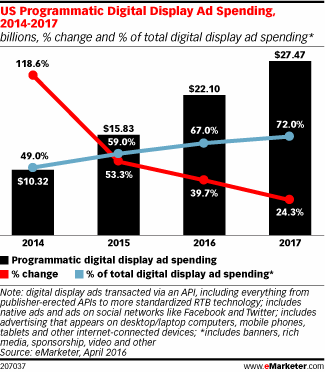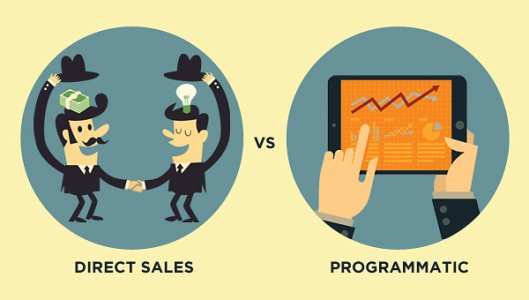If you haven’t yet heard of programmatic advertising or know how it works, you need to catch up with the times. Traditionally, buying and selling display advertising on the Internet worked a lot like display advertising in print, television, and other more old-school mediums. It required an interaction between an advertiser and a sales person, the negotiation of a purchase of ad space, and so on. Essentially, it needed two humans, speaking with each other.
Not so with programmatic. Programmatic advertising is changing the way online display advertising (and even some more “traditional” advertising) works. According to eMarketer, programmatic digital display ad spending jumped from $10B in 2014 to $22B this year, and programmatic is going to account for over two thirds of all digital display ad buying.

Whether you’re a marketing agency looking to branch out or a business that wants to try something new, you should know not just what programmatic is, but what makes it so critical to the evolving digital marketing landscape.
So What Exactly Is Programmatic Advertising?
Depending on who you ask, programmatic advertising is either a software solution or the simple automation of display ad buying. Sometimes it’s both. In reality, it can be either one. Programmatic advertising brings data into the ad buying equation and makes the process both automated and programmable through algorithms and software platforms. This cuts out the key element of the old ad buying interaction that required a salesperson and makes the whole process more efficient.

People are still involved, however. Marketing agencies and large businesses often dedicate entire teams to management of programmatic buying, tweaking the targeting and optimization of buys as well as overseeing any parts of the process that aren’t completely automated, which are actually many. Like with any new advanced technology, programmatic ad buying can’t do everything on its own (so don’t worry, this isn’t a case of jobs being entirely replaced by robots); it still needs monitoring by highly skilled people who understand marketing data and trends, and can nudge the technology in the right direction when needed.
There are a few different types of programmatic to know about. There can be quite a few different types depending on who you ask, but here are the basics:
- Open Auction/Open Marketplace/Real-Time Bidding (RTB) – Real-time bidding has so many names because RTB can refer to both a programmatic ad type and a type of transaction. Hence why it also gets referred to as Open Auction or Open Marketplace. RTB is the most basic and currently the most common kind of programmatic, with ad inventory available to all bidders in an open auction with, you guessed it, real-time bidding.
- Private Marketplace (PMP) – These marketplaces are a little more exclusive. Access to them is granted only to certain buyers, or even a single buyer, and even the ad inventory might be restricted or specially selected. The primary purpose of PMP is to exercise control over where your ads will run, which is why the buyers are limited.
- Automated Guaranteed – Like the name says, this is the most heavily automated of the programmatic ad types. In Automated Guaranteed, the ad inventory is reserved in advance, and pricing comes fixed. Additionally, the RFP and campaign routing process is fully automated through a software platform. This type is rapidly growing in popularity versus RTB.
Now that you know what programmatic is all about, you need to know why it’s become so popular so quickly in the last two years.
Why Is Programmatic Advertising So Important?
There are four main reasons. Let’s break them down:
- Scale: the power of programmatic is its incredible scalability at a volume direct buy could never have reached. In the days of direct buy, or even in current “traditional” media buys, you would be limited by smaller inventories and lesser reach. The power of programmatic allows you to reach a vast amount of people all across the Internet wherever they go through the power of retargeting. Programmatic allows you to purchase any inventory available on the Internet, provided you have the budget available.
- Real-Time Flexibility: Another problem with direct buy is that it doesn’t permit any adjustments once your purchase has been made. It’s set, and all you can do is let it run its course regardless of whatever performance you’re seeing. Programmatic, however, allows you to make changes in real time based on the impressions that you’re getting.
- Targeting: With programmatic, you can also layer in way more targeting criteria pretty cheaply in order to reach exactly the audiences you want, all at the previously mentioned huge scale. For example, you could layer thousands of specific in-market audiences into your targeting reaching all across the Internet and make your advertising much more efficient, saving you money on spend while making you more money per impression. When it comes to big data, demographics, interests, in-market audiences, and more are only the start of the kind of layers you could add to your targeting. Layering in targeting criteria all through one platform is one of the biggest benefits to programmatic advertising.
- Efficiency: Here at Wpromote, we use programmatic advertising for some of our biggest clients, and we do it to make their spending more efficient. For example, if we have extra money in a client’s advertising budget, we can plug it into their programmatic partner and layer in that client’s very specific targeting criteria. Because programmatic is so cost-efficient, even a small piece of budget can go a very long way, and that client will make back four to five times what they’ve spent.
So the question you may be coming away from all this with is: should I be using programmatic advertising? To decide that, it really depends on whether or not you have a need for any or all of the four reasons stated above, and if you think the types of programmatic would work for you. What isn’t in question is the surging importance of programmatic in display advertising and why it’s become so critical to digital marketers!






Responses